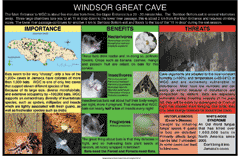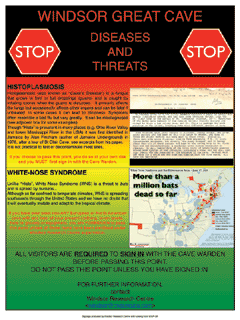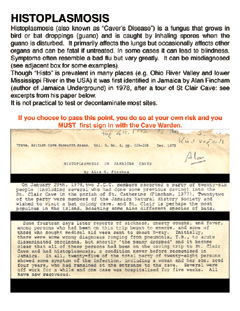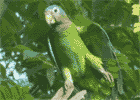| Click for larger image | ||||
|---|---|---|---|---|
 |
 |
 |
 |
|
.gif) Windsor Great Cave is approximately 3 km
long and parts of it are still subject to water flows during heavy rains, so it is still active and being carved out of the limestone hills by water flow.
Windsor Great Cave is approximately 3 km
long and parts of it are still subject to water flows during heavy rains, so it is still active and being carved out of the limestone hills by water flow.
It is not generally realised that caves in limestone hills have a finite life
as they migrate upwards through the hillside. This migration is
caused by successive collapses of the ceiling due to the
dissolution effects of water percolating downwards. Obviously,
every time the ceiling collapses, the ceiling gets higher and the
floor is raised by the debris: so the whole chamber gets
higher.
Windsor Cave is an important roost for bats: a colony of at least 100,000 lives there and is responsible for the slippery "mud" that covers the floor. This bat guano used to be mined from deep in the cave during the 1930's but as we now know, guano extraction can cause the destruction of unique guano-dependent invertebrate communities, can lead to the introduction into caves of invasive alien species like the American Cockroach (Periplaneta americana), and can lead to the extirpation of the entire bat colony! In 1999 Windsor Research Centre launched a research & monitoring programme on the bats of Windsor.
Any visitation to any cave with native fauna is a threat to the cave ecosystem because cave species tend to be very sensitive to the smallest microenvironmental changes, with a result that they are unable to adapt to changes and go extinct or, if possible, abandon the cave. Please read our brochure and consult the Cave Warden before entering the Cave.
HEALTH CAUTION FOR CAVE
EXPLORATION IN JAMAICA (Fincham 1997):
Histoplasmosis is a human fungal disease
resulting from infection with the organism Histoplasma
capsulatum, and is a potential hazard to anyone entering a
tropical cave. Pulmonary histoplasmosis causes flu-like symptoms
and, in severe cases, requires hospitalization. The fungus is
considered common in Jamaican caves and is closely-linked with, but
not exclusive to, cave-dwelling bats. A brief exposure is likely to
result in infection. This was first recognized in 1978 when, a
group of visitors were taken into a Jamaican cave; 25 of the 28
subsequently showed some symptom of the infection, including a
woman and her son, aged 4yrs, who had remained at the cave entrance
(Fincham 1978). Histoplasma spores may be present in dry
guano piles even if the cave is no longer occupied by bats. Any
persons known to be immunologically compromised should not expose
themselves to the risk of histoplasmosis and all visitors to
Jamaican caves should be aware that infection probabilities are
high and must sign a Disclaimer before entering the Cave.
The entrance to Windsor Cave was formerly part of the Windsor estate: in the 1930's, it was exploited for guano and publicised for tourism by Willy Donald-Hill. The next owner, Miriam Rothschild, retained the Cave entrances when she sold Windsor in the 1950's and has donated this land to the World Wildlife Fund for Nature (WWF-UK) in 1995.
The map is copied from Alan Fincham's very excellent book, Jamaica Underground, 1997, The Press, University of the West Indies. ( BUY a Copy).

